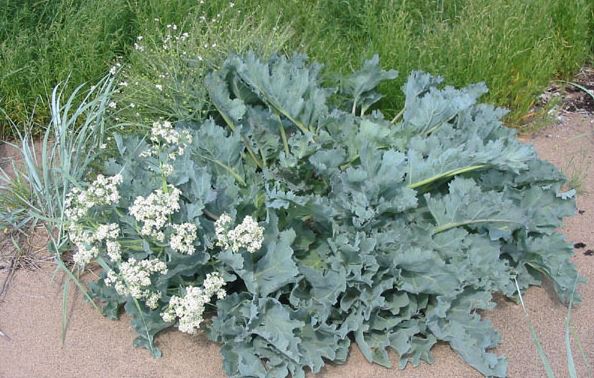
Botanical Classification
Sea kale, scientifically known as Crambe maritima, belongs to the Brassicaceae family, which includes other leafy greens like kale, cabbage, and broccoli. It is a perennial herbaceous plant, distinct from true kales (Brassica oleracea), though it shares similar nutritional and culinary traits.
Within the genus Crambe, sea kale is one of about 20 species, characterized by its adaptation to coastal environments. Its classification reflects its close relation to other cruciferous vegetables, known for their sulfur-containing compounds and health benefits.
Origin and History
Sea kale is native to the coastal regions of Europe, particularly along the shores of the North Atlantic, from the British Isles to the Baltic Sea. It has been foraged for centuries, valued by coastal communities for its edible leaves, shoots, and roots. In the 18th and 19th centuries, sea kale gained popularity in Victorian England, where it was cultivated and blanched under clay pots or sand to produce tender, pale shoots, considered a delicacy. Its cultivation declined in the 20th century but has seen a revival among foragers, gardeners, and chefs interested in heirloom and wild edibles.
Identifying Characteristics

Sea kale is a striking plant with thick, waxy, blue-green leaves that are broad, lobed, and slightly crinkled, giving a glaucous appearance. It grows in a low rosette, typically 1–2 feet tall and wide, with fleshy stems and roots adapted to sandy, saline soils. In spring, it produces clusters of small, white, four-petaled flowers on tall stalks, followed by round, pod-like seeds. Young shoots are pale and tender when blanched, resembling asparagus, while mature leaves are tougher and more cabbage-like in texture.
Seasons/Availability
Sea kale is a perennial that thrives in coastal climates, with peak availability in spring and early summer (March to June in the Northern Hemisphere). Young shoots and leaves are harvested in early spring, often blanched to maintain tenderness. Wild sea kale can be foraged along coastlines during this period, while cultivated plants may extend availability into summer. Mature leaves are available later but are less tender. In markets, sea kale is rare, typically found at specialty grocers or farmers’ markets in coastal regions or through foragers.
Culinary Use
Sea kale is prized for its versatility, with different parts offering unique textures and flavors. Young, blanched shoots are tender and nutty, often steamed or lightly boiled as an asparagus-like side dish, served with butter or hollandaise sauce. Fresh leaves can be eaten raw in salads when young or cooked like spinach or kale when mature, with a mild, cabbage-like flavor. The roots, though less common, are edible when cooked, with a starchy, slightly bitter taste. Sea kale pairs well with seafood, lemon, or creamy sauces, making it a favorite in coastal European cuisines.
Nutritional Value
Sea kale is a nutrient-dense vegetable, rich in vitamins and minerals typical of the Brassicaceae family. It is an excellent source of vitamin C, supporting immune health and antioxidant activity, and vitamin K, essential for blood clotting and bone health. It also provides folate, vitamin A (as beta-carotene), and dietary fiber, promoting digestive health. Sea kale contains glucosinolates, sulfur compounds linked to anti-cancer properties, similar to other cruciferous vegetables. Its mineral content includes calcium, magnesium, and potassium, though exact values vary depending on soil conditions and preparation methods.
Cultivation of Sea Kale (Crambe maritima)
- Climate and Hardiness: Sea kale thrives in temperate coastal climates, hardy in USDA zones 4–8. It tolerates salty air and mild frost but prefers cool, moist conditions similar to its native European shorelines.
- Soil Requirements: Plant in well-drained, sandy or loamy soil with a pH of 6.0–7.5. Sea kale adapts to poor, saline soils but benefits from added organic matter like compost to improve fertility and drainage.
- Site Selection: Choose a sunny location with full sun (6–8 hours daily) for optimal growth. Partial shade is tolerated but may reduce vigor. Coastal or exposed sites mimic its natural habitat.
- Propagation by Seed: Sow seeds in spring or fall, ½ inch deep, in a seed tray or directly in the ground. Soak seeds overnight to aid germination, which takes 2–3 weeks at 60–70°F (15–21°C).
- Propagation by Root Cuttings: Take 4–6 inch root cuttings from mature plants in late winter or early spring. Plant horizontally in moist soil, 2 inches deep, for faster establishment than seeds.
- Planting: Transplant seedlings or root cuttings in spring, spacing plants 18–24 inches apart in rows 2–3 feet apart. Ensure the crown is level with the soil surface to prevent rot.
- Watering: Keep soil consistently moist but not waterlogged, especially during establishment. Once established, sea kale is drought-tolerant but benefits from occasional deep watering in dry spells.
- Fertilization: Apply a balanced fertilizer (e.g., 10-10-10) or compost in early spring to boost growth. Avoid high-nitrogen fertilizers, which promote leafy growth at the expense of shoots and roots.
- Blanching for Tender Shoots: To produce tender, pale shoots, blanch young shoots in early spring by covering with a clay pot, bucket, or mound of sand/soil for 2–3 weeks, mimicking Victorian cultivation techniques.
- Weed Control: Mulch around plants with straw or gravel to suppress weeds and retain moisture. Hand-weed regularly, as sea kale’s shallow roots compete poorly with aggressive weeds.
- Pest and Disease Management: Sea kale is relatively pest-resistant but may attract cabbage worms or aphids. Use row covers or organic sprays like neem oil. Ensure good drainage to prevent root rot, the primary disease concern.
- Harvesting: Harvest blanched shoots in spring when 6–8 inches long, cutting at the base. Pick young leaves for salads or cook mature leaves like spinach. Harvest sparingly in the first year to allow establishment.
- Maintenance and Perennial Care: Cut back flower stalks after blooming to encourage leaf growth, unless saving seeds. Divide mature plants every 3–4 years in early spring to rejuvenate and propagate. Protect with mulch in harsh winters.